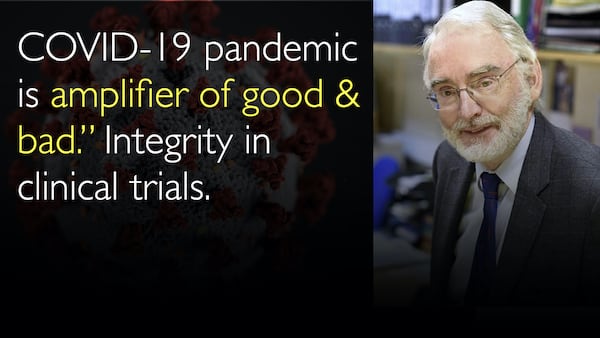Dr. Anton Titov, MD, reports a 10 to 20 times lower response rate from female physicians compared to male colleagues of similar seniority. This imbalance persists despite women making up over 50% of the video audience and being primary healthcare decision-makers in families. Dr. Wolf expresses surprise at the data and confirms his extensive experience training hundreds of female physicians who are typically willing to share their expertise. The conversation highlights a puzzling and persistent challenge in achieving gender-balanced medical media representation.
Addressing the Gender Gap in Medical Expert Interviews
Jump To Section
- Interview Response Disparity Between Genders
- Audience Demographics vs Expert Participation
- Impact on Healthcare Information Dissemination
- Perspectives from a Medical Educator
- Potential Solutions and Next Steps
- Full Transcript
Interview Response Disparity Between Genders
Dr. Anton Titov, MD, reveals a stark gender disparity in physician interview response rates. Female physicians demonstrate a 10 to 20 times lower response rate compared to their male counterparts. This significant gap occurs despite targeting medical leaders of similar seniority and accomplishment. The pattern holds true across both United States and European medical communities.
For every 50 interviews conducted with male medical experts, only one features a female expert. This 50:1 ratio presents a major challenge for balanced medical media representation. The consistency of this pattern across different geographic regions suggests systemic rather than cultural factors.
Audience Demographics vs Expert Participation
The interview participation gap contrasts sharply with audience demographics. Women constitute over 50% of viewers consuming medical expert content. This disconnect between content creators and content consumers represents a critical imbalance in medical information dissemination.
Dr. Anton Titov, MD, emphasizes the importance of aligning expert representation with audience composition. The current disparity means female viewers receive medical information primarily from male voices. This mismatch may affect how healthcare information is perceived and utilized by its primary audience.
Impact on Healthcare Information Dissemination
The gender imbalance in medical interviews has practical implications for healthcare decision-making. Women typically make the majority of important healthcare decisions within families globally. This reality makes female physician perspectives particularly valuable for patient education.
Dr. Anton Titov, MD, expresses serious concern about the current ratio of expert representation. He actively seeks a 50/50 gender balance in medical interviews to better serve the audience. Achieving this balance would ensure diverse perspectives reach those making critical health choices.
Perspectives from a Medical Educator
Dr. Marshall Wolf, MD, brings extensive experience from training hundreds of physicians throughout his career. He estimates having trained between 400 and 700 female physicians specifically. Based on this experience, Dr. Wolf expresses surprise at the low response rate from female colleagues.
Dr. Marshall Wolf, MD, notes that most female physicians he trained would likely be willing to participate in expert interviews. His perspective suggests the response gap may not reflect general unwillingness among female physicians. The noted disparity puzzles an experienced medical educator familiar with physician engagement patterns.
Potential Solutions and Next Steps
Addressing this gender gap requires understanding its underlying causes. Both Dr. Anton Titov, MD, and Dr. Marshall Wolf, MD, acknowledge the mystery surrounding the response rate disparity. Identifying barriers—whether structural, cultural, or logistical—represents the first step toward solution development.
Potential approaches include examining outreach methods, interview formats, and perceived value propositions for female experts. Dr. Marshall Wolf, MD, suggests involving more female physicians in the conversation, including his physician wife. Continued dialogue between medical media producers and physician educators remains essential for progress.
The goal remains achieving gender-balanced expert representation that matches audience demographics. This alignment ensures diverse medical perspectives reach those making critical healthcare decisions worldwide.
Full Transcript
Dr. Anton Titov, MD: The goal of this project is to interview at least a thousand top leaders in medicine around the world.
Dr. Marshall Wolf, MD: We get around ten to twenty times worse rate of response from female physicians than from male physicians. From people of similar seniority, both in the United States and in Europe. I have one interview with a female medical expert for every 50 interviews with male medical experts.
But women make over 50% of people who view the videos. Women make a lot of very important health care decisions in a family. It is true around the world. I'm very much bothered by that ratio. I would certainly like to have a 50/50 ratio of interviews with female and male physicians.
Dr. Anton Titov, MD: How to improve the positive response rate from the female physicians? How to improve a gender mix of interviews? So that gender of interviewees could be more balanced to that of people who view the videos.
Dr. Marshall Wolf, MD: I have no idea why that is. I mean, that is interesting. My wife is a physician. I would've thought if you had asked her, she would be glad to give you an interview. It would've been much more interested than talking to me.
I trained 400-500, maybe a 1,000 physicians. Perhaps it is more likely between 400 and 700 female physicians. Most of them would also be willing to speak to you.
But I have no idea of why your response rate is off. Why it is different between males and females. I was puzzled, but it became a very apparent fact. I hear your comment and I accept your data. But I have no idea of why that should be, and I am surprised.
Dr. Anton Titov, MD: Dr. Wolf, thank you very much for this conversation. I appreciate your time! It will be very interesting for viewers around the world. We hope to be able to come back to you, and perhaps to your wife, in the future. Thank you for training thousands of physicians and for being an inspiration for many thousands more!
Dr. Marshall Wolf, MD: You are welcome, thank you for the interview!
I get 10-20x worse rate of response from female physicians to talk about their research and clinical expertise vs. male doctors of the same seniority. Eminent physician and medical educator, Dr. Marshall Wolf, is equally puzzled.






